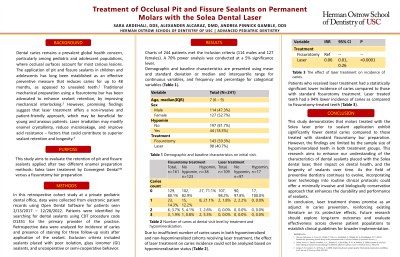Preventive
A Retrospective Cohort Analysis Comparing Sealant Efficacy with Solea Laser
100 - Treatment of Occlusal Pit and Fissure Sealants on Permanent Molars with the Solea Dental Laser


Sara Ardehali, DDS
Pediatric Dental Resident
University of Southern California
University of Southern California
Los Angeles, California, United States- AG
Andrea Gamble, DDS
University of Southern California Herman Ostrow School of Dentistry
Redondo Beach, California, United States - AA
Alexander Alcaraz, DMD
Program Director
Herman Ostrow School of Dentistry
Los Angeles, California, United States
Presenting Author(s)
Research Mentor(s)
Program Director(s)
Purpose: This study aims to evaluate the retention of pit and fissure sealants applied after two different enamel preparation methods: Solea laser treatment by Convergent Dental versus a fissurotomy bur preparation.
Methods: In this retrospective cohort study at a private pediatric dental office, data were collected from electronic patient records using Open Dental Software for patients seen 2/13/2017 – 12/20/2022. Patients were identified by searching for dental sealants using CDT procedure code D1351 for the primary provider of the practice. Retrospective data were analyzed for incidence of caries and presence of staining for three follow-up visits after application of the sealant. Exclusion criteria included sealants placed with poor isolation, glass ionomer (GI) sealants, and uncooperative or semi-cooperative behavior.
Results: Charts of 244 patients met the inclusion criteria (114 males and 127 females). A 70% power analysis was conducted at a 5% significance level. Demographic and baseline characteristics are presented using mean and standard deviation or median and interquartile range for continuous variables, and frequency and percentage for categorical variables (Table 1). Due to insufficient number of caries cases in both hypomineralized and non-hypomineralized cohorts receiving laser treatment, the effect of laser treatment on caries incidence could not be analyzed based on hypomineralization status (Table 2). Patients who received laser treatment had a statistically significant lower incidence of caries compared to those with standard fissurotomy treatment. Laser treated teeth had a 94% lower incidence of caries as compared to fissurotomy-treated teeth (Table 3).
Conclusion: This study demonstrates that molars treated with the Solea laser prior to sealant application exhibit significantly fewer dental caries compared to those treated with standard fissurotomy bur preparation. However, the findings are limited by the sample size of hypomineralized teeth in both treatment groups. This research aims to enhance our understanding of the characteristics of dental sealants placed with the Solea dental laser, their impact on dental health, and the longevity of sealants over time. As the field of preventive dentistry continues to evolve, incorporating laser technology into routine clinical protocols could offer a minimally invasive and biologically conservative approach that enhances the durability and performance of sealants.
In conclusion, laser treatment shows promise as an adjunct in caries prevention, reinforcing existing literature on its protective effects. Future research should explore long-term outcomes and evaluate effectiveness across diverse patient populations to establish clinical guidelines for broader implementation.

.jpg)